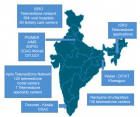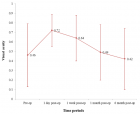About University of Electronic Science and Technology of Chengdu
University of Electronic Science and Technology of Chengdu
Articles by University of Electronic Science and Technology of Chengdu
The bio-energy transport in the protein molecules and its experimental validations of correctness
Published on: 18th January, 2018
OCLC Number/Unique Identifier: 7355943543
The bio-energy released by the hydrolysis of adenosine triphosphate, which relate to plenty of life activities and is transported in a solution, and its theory of transport are first stated and built in helix protein molecule. In order to confirm and verify the correctness of the transported theory we here systematically summarized and reviewed a great number of experimental investigation and evidences obtained by us and other researchers in past 30 years, involving the real existences of the solution and its features and lifetimes. In this survey we outlined and presented concretely the features of infrared spectra of absorption, Raman spectra and specific heat of the molecular crystal-acetanilide collagen, bivine serum albumin, myoglobin proteins and E.Coli. cell as well as the lifetimes of the solution in acetanilide and myoglobin measured by using pump-probe techniques and free-electron laser experiment, in which we give not only experimental data but also their comparisons with theoretical results. These experimental data and evidences provided here are enough to verify and affirm the true existences of the new solution, which can complete itself functions of bio-energy transport in the lifetime, and the correctness of the new theory of bio-energy transport in the acetanilide and protein molecule. Thus we can affirm the correctness of theory of the bio-energy transport in helix protein molecule, which can greatly promote the development of molecular biology.
The properties of nonlinear excitations and verification of validity of theory of energy transport in the protein molecules
Published on: 9th April, 2018
OCLC Number/Unique Identifier: 7906092414
Based on different properties of structure of helical protein molecules some theories of bio-energy transport along the molecular chains have been proposed and established, where the energy is released by hydrolysis of adenosine triphosphate (ATP). A brief survey of past researches on different models and theories of bio-energy, including Davydov’s, Brown et al’s, Schweitzer’s, Cruzeiro-Hansson’s, Forner‘s and Pang’s models were first stated in this paper. Subsequently we studied and reviewed mainly and systematically the properties and stability of the carriers (solitons) transporting the bio-energy at physiological temperature 300K in Pang’s and Davydov’s theories. However, these theoretical models including Davydov’s and Pang’s model were all established based on a periodic and uniform proteins, which are different from practically biological proteins molecules. Therefore, it is very necessary to inspect and verify the validity of the theory of bio-energy transport in really biological protein molecules. These problems were extensively studied by a lot of researchers and using different methods in past thirty years, a considerable number of research results were obtained. I here reviewed the situations and progresses of study on this problem, in which we reviewed the correctness of the theory of bio-energy transport including Davydov’s and Pang’s model and its investigated progresses under influences of structure nonuniformity and disorder, side groups and imported impurities of protein chains as well as the thermal perturbation and damping of medium arising from the biological temperature of the systems. The structure nonuniformity arises from the disorder distribution of sequence of masses of amino acid residues and side groups and imported impurities, which results in the changes and fluctuations of the spring constant, dipole-dipole interaction, exciton-phonon coupling constant, diagonal disorder or ground state energy and chain-chain interaction among the molecular channels in the dynamic equations in different models. The influences of structure nonuniformity, side groups and imported impurities as well as the thermal perturbation and damping of medium on the bio-energy transport in the proteins with single chain and three chains were studied by differently numerical simulation technique and methods containing the average Hamiltonian way of thermal perturbation, fourth-order Runge-Kutta method, Monte Carlo method, quantum perturbed way and thermodynamic and statistical method, and so on. In this review the numerical simulation results of bio-energy transport in uniform protein molecules, the influence of structure nonuniformity on the bio-energy transport, the effects of temperature of systems on the bio-energy transport and the simultaneous effects of structure nonuniformity, damping and thermal perturbation of proteins on the bio-energy transport in a single chains and helical molecules were included and studied, respectively. The results obtained from these studies and reviews represent that Davydov’s soliton is really unstable, but Pang’s soliton is stable at physiologic temperature 300K and underinfluences of structure nonuniformity or disorder, side groups, imported impurities and damping of medium, which is consistent with analytic results. Thus we can still conclude that the soliton in Pang’s model is exactly a carrier of the bio-energy transport, Pang’s theory is appropriate to helical protein molecules.

If you are already a member of our network and need to keep track of any developments regarding a question you have already submitted, click "take me to my Query."

















































































































































